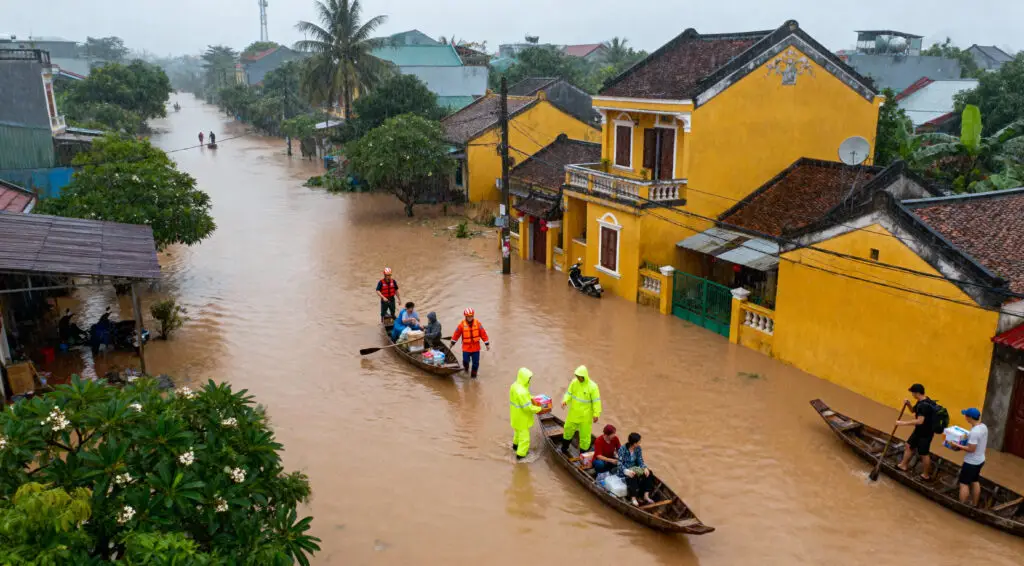Floods Devastate Central Vietnam Provinces
In central Vietnam, record-breaking rain has caused severe floods that have killed 35 people and left five more missing. The Vietnam Disaster and Dyke Management Authority says that the deaths happened in the provinces of Hue, Da Nang, Lam Dong, and Quang Tri.
Last weekend, up to 1.7 meters of rain poured in only 24 hours, flooding houses and farms. Officials reported the floodwaters were higher than they have been in 60 years, forcing thousands of residents to leave their homes.

Ancient Hoi An Submerged Under Historic Flood Levels
The small alleyways of Hoi An, a UNESCO World Heritage Site, were covered in water up to the waist. After a local river overflowed, people used boats to get about on flooded roadways.
Chuong Nguyen, who lives in the area, claimed many residents were astonished by the abrupt rise. Many homes weren’t ready, and many lost everything when the floodwaters rose quicker than planned, leaving towns with little way to aid.
Thousands of Homes and Farms Suffer Severe Damage
Authorities said that more than 16,500 homes are still submerged and that devastation has spread to numerous regions. Floodwaters took away more than 40,000 animals and birds, and 5,300 hectares of crops were underwater.
Earlier this week, officials said that more than 100,000 houses had been inundated and more than 150 landslides had happened. Local economies are having a hard time getting back on their feet because of the scope of the damage.
Recommended Article: Deadly 6.3-Magnitude Earthquake Strikes Northern Afghanistan, Killing Nine
Climate Change Worsening Flood Intensity and Frequency
Experts say that climate change is making extreme weather events like storms and floods worse and harder to anticipate. As the world’s temperatures rise, so do the amount of rain that falls and the damage these catastrophes do.
Vietnam is in one of the most active areas for tropical cyclones on Earth. Every year from June to September, the country is hit by floods and typhoons, which make it harder for rural areas to bounce back.
Vietnam Exceeds Annual Storm Average in 2025
Vietnam usually has approximately 10 tropical storms or typhoons per year, either on land or at sea. But by 2025, the country has already been hit by 12, which is more than the historical average.
The storms that happen a lot have made flash floods and landslides more likely, especially in the mountains. Government agencies are increasingly putting evacuation planning and initiatives to lower the risk of disasters at the top of their lists.
Economic Losses Exceed $610 Million Nationwide
Natural catastrophes, including storms, floods, and landslides, killed or made 187 people go missing across the country in the first nine months of 2025. The Vietnamese government said that the overall economic damages were more than $610 million.
Officials said that more floods might make recovery expenses much higher. Rebuilding housing, fixing infrastructure, and bringing back important agricultural output are the main goals of reconstruction operations.
Urgent Need for Stronger Preparedness and Relief Support
Rescue teams and emergency aid have been sent to the provinces that were hit the worst. Relief efforts are still going on, but it is still hard to get to certain regions because of blocked roads and rain that keeps falling.
Humanitarian groups are asking for more international help and money to help people adapt to climate change. Experts say that Vietnam has to build stronger flood defenses, make better predictions, and spend money on long-term water management.
A Nation Resilient but Facing Growing Climate Risks
Vietnam’s ability to bounce back from natural calamities shows how strong its communities are. But if global warming speeds up, these kinds of occurrences are likely to happen more often and on a larger scale, which might overwhelm local resources.
Officials and environmentalists believe that it is very important to establish long-term resilience through green infrastructure and early warning systems. Future storms might be considerably more deadly if we don’t take strong action on climate change.























